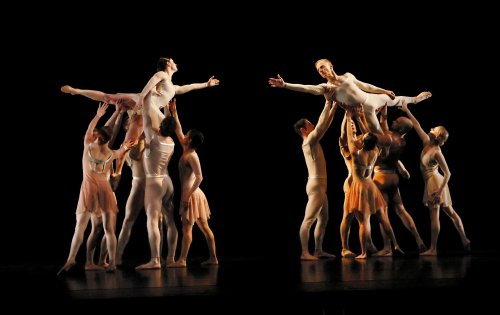Paul Taylor American Modern Dance: Spring Season 2017
A modern dance master shows off a brilliantly wide-ranging repertoire while also including exciting works by other choreographers.

Parisa Khobdeh and George Smallwood in Paul Taylor American Modern Dance’s revival of “Diversion of Angels” (Photo credit: Paul B. Goode)
[avatar user=”Joel Benjamin” size=”96″ align=”left” ] Joel Benjamin, Critic[/avatar]Three performances. Nine ballets—five by Paul Taylor. One conclusion: The Paul Taylor dancers are at the top of their form, particularly when dancing his repertory which demands speed, strength and style.
Now named Paul Taylor American Modern Dance, Taylor has included ballets by other choreographers which allows for some healthy comparisons and a hope for the future of this legendary company. The four non-Taylor works, all but one danced by the Taylor dancers, made fascinating comparison with his work: particularly Martha Graham’s “Diversion of Angels,” her ode to romantic and sexual love, choreographed in 1948 to music by Norman Dello Joio, one of the few works in which Graham, herself, did not appear.
Taylor’s early style owed a great deal to Graham’s whose company he danced in during the fifties, so the dance vocabulary of “Angels” should not have provided any problem for them, but somehow, these fine dancers never got the ecstasy of Graham’s movement, most particularly Parisa Khobdeh who danced the Girl in Red for whom Graham’s signature movement, the contraction (sudden pulling in of the abdomen as if punched), represents orgasmic delight, seemed superficially applied to series of high leg tilts. Laura Halzack and Michael Trusnovec managed to communicate the pain of love coming apart of the mature Couple in white.

Julia Carnicer and Elsa Monguillot de Mirman in a scene from Paul Taylor American Modern Dance’s revival of “Summerspace” (Photo credit: Paul B. Goode)
Merce Cunningham, another Martha Graham alumnus, was represented by his calm-to-the-point-of-stultifying “Summerspace,” famous for its mottled costumes, mimicking the backdrop, painted by Robert Rauschenberg. Morton Feldman’s “Ixion” was the pointilistic, episodic score to which the six dancers from the Lyon Opera Ballet performed quiet arabesques, lunges, leans, small leaps, etc. that rarely filled the stage nor made any sense except for the moment-to-moment views of these fine dancers doing the fairly simple steps with cool elegance.
Two non-Taylor works danced by his company were the extremely busy, dark and overly violent “Rush Hour” by Larry Keigwin to a noisy, pounding score by Adam Crystal and the much calmer, if not idyllic “Continuum” a world premiere by Taylor alumna, Lila York.
York’s work, to Max Richter’s dark variations on Vivaldi’s “Four Seasons,” was for fourteen dancers. Madelyn Ho was the standout, zipping among the lovely groupings. “Continuum” was pleasant, using an interesting hybrid of Taylor’s weighty vocabulary (flex-footed tilts, loping runs, slides on the floor) and ballet steps. York is an experienced choreographer but somehow “Continuum” never quite gelled, although it provided a fine portrait of a little community that loved to move together.

Laura Halzack, Michael Trusnovec and company in a scene from Paul Taylor American Modern Dance’s premiere of “Continuum”” (Photo credit: Paul B. Goode)
Keigwin, on the other hand, provided a dark, brooding portrait of urban chaos, with dancers crashing into each other and partnering veering into angular wrestling matches. The Taylor dances zipped through this work which ended a program on a down note.
Two works to Bach, “Brandenburgs” and “Promethean Fire” showed two totally different sides of Taylor’s creativity. The first was “classical” Taylor, using the music as a support for lovely, witty images while the latter was darker, almost Wagnerian in its mood, taking its cue from the ponderous Leopold Stokowski arrangement of two organ work.
Three Taylor works stood out for different reasons. The first is the high energy “Syzygy” to a score by Donald York in which the dancers became a veritable blur of superhuman speed, so brilliantly and perfectly performed that even the audience was exhausted and elated by the end. “The Word,” to music by David Israel was a psychologically dark work in which the cast, dressed in school uniforms by Santo Loquasto (Taylor’s go-to costume designer for most of his works) are controlled by social pressures and forces beyond their ability to resist.

Michael Trusnovec and Company in Paul Taylor American Modern Dance’s premiere of “Ports of Call” (Photo credit: Paul B. Goode)
The third work, a new piece by Taylor called “Ports of Call” to two famous Jacques Ibert scores was a silly travelogue which took the audience to Africa, Hawaii, Alaska and a folksy Midwest, U.S.A. It was cartoony with some of the ethnic caricatures bordering on silly, but beautifully performed. Taylor has lately been criticized for this kind of work, but, as a master craftsman in his mid-eighties, he deserves to let loose and be just entertaining. After all, even Balanchine had his “PAMTGG.” (Look it up!)
The lighting, mostly by Jennifer Tipton, another Taylor diehard, was brilliant throughout, as were the costumes by Loquasto (although I disagree with some of his color choices).
All the music was performed impeccably and live by the Orchestra of St. Luke’s conducted by Ted Sperling and Donald York whose intimate relationship with the dances and dancers gave each work its own spark.
Paul Taylor American Modern Dance – Spring 2017 Season (March 8 – 26, 2017)
David H. Koch Theater, Lincoln Center, in Manhattan
For tickets, call 212-496-0600 or visit http://www.boxoffice.dance
For further information, visit http://www.ptamd.org






Leave a comment